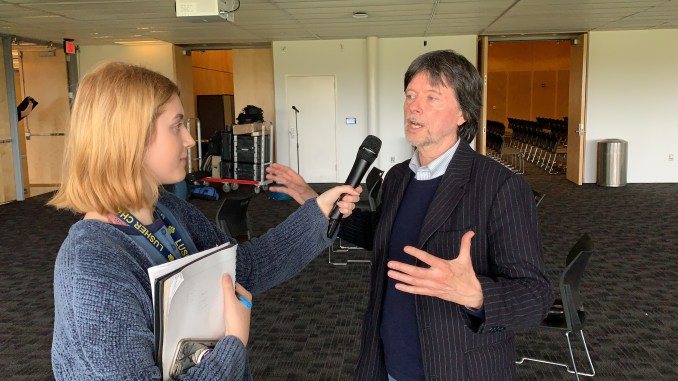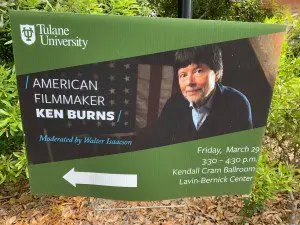
Editor’s Note: This piece was written by Isabella Brown, a participant in the Junior Journalism Program of New Orleans. It originally appeared on their website and has been reprinted with permission.
Ken Burns is a prominent name among documentarians and is best known for his masterful depiction of historical events in documentaries such as The Civil War and The Vietnam War. As he visited Tulane on March 29, he discussed an array of topics with history professor Walter Isaacson. The topics ranged from the Civil War and current politics to his upcoming documentaries and his filmmaking style.
Another highlight of the seminar was the discussion of the highly anticipated Country Music series. A sneak peek look at the series was shown and featured interviewees such as Dolly Parton. As Burns described the process of creating the series, he recounted conducting 101 interviews, 20 interviewees of which have already passed, and gathering 175 hours of footage, 80 of which will actually be in the series. Indeed, this massive accumulation of hours and hours of interactions seems to be a common feature of his films. After the seminar, when I got the chance to talk with Burns, I couldn’t help but ask how he chooses whose stories to tell when he is exposed to so many different ones.

“My job, it is about choosing and it is difficult and you make mistakes and you unchoose… it is a merciless and sometimes incredibly painful triage… Just imagine a sculptress who brings a block of stone to her studio and chips away at it for however long and the final product is exhibited in a gallery or a museum. We only know what’s left. She has to know what I call the negative space of creation, all of that rubble that’s on the floor of her studio that’s not in it, that is as important to the artist as the finished thing is some ways… It is about subtraction, what we do… less being more in a funny way. And yet, you have to figure out some relationship, some way to honor that negative space… so we’re constantly going back and looking at the interviews… but it’s hundreds and hundreds of hours of stuff… I would say… listen to the material more.”
The Confederate monument question remains a prominent historical debate here in New Orleans, so it is no surprise that the seminar started out with a lengthy discussion of Burns’ documentary The Civil War and, furthermore, the Confederate monument debacle itself. At one point, Tulane professor Walter Isaacson asked, “Do you think that by pulling down these monuments we’re losing some feel for history?” Burns responded, “No, we’re actually increasing our feel for history. We’re making it much more dimensional. We’re asking other people who have been involved in this narrative, who have systematically and consciously been excluded from the narrative to come in and have a place…”
It is obvious that African Americans have been historically excluded from the conversation and what Burns is discussing is the fact that Confederate monuments have been around since after the Civil War and we are only just beginning to discuss them now because their racist significance is finally being acknowledged. In other words, what African Americans and many others are finally acknowledging is that what these monuments truly stand for is not southern heritage, but, in fact, stand for a time in which half of the population glorified the subjugation of the other, African American half of the population. Burns emphasized this same point and stated, “I think our narration goes ‘there were 31 million people living peaceably in small towns and farms in 1861, 22 million in the North and 9 million in the South.’ In the South, there are 9 million human beings, right? Four million of them, 45%, are African Americans slaves who have zero interest despite all of the Lost Causers who’ll try to convince you how many African Americans fought for the Confederacy; zero interest in the perpetuation of the institution of slavery.”
As Burns puts it, almost half of the population consisted of enslaved African Americans who were not supportive of the Confederate cause and the fact that people currently argue that Confederate monuments stand for southern patriotism and pride is simply not true. The African American population felt no pride in being enslaved. What Burns was discussing was the fact that taking down the Confederate monuments increases our feel for history because it increases our empathy towards subjugated groups of the past and, furthermore, allows room for improvement in our current society when we discuss such issues and let the people who were directly affected have a voice. When the issue in discussion is whether we should continue to immortalize and glorify men who wanted to enslave people based on the color of their skin, the answer is pretty obvious. As Ken Burns himself put it, “There are some things that are really clear in American life. Take it down, lock it up.”
Another distinct characteristic of Burns’s documentaries is his use of zooming on to still images, referred to famously as the Ken Burns Effect. Burns described his mindset when using the effect to Walter Isaacson and the audience, explaining, “What I am doing is I’m taking a still photograph and treating it, not at arms-length like a slideshow, but saying this is a representation of a once fully alive moment. It had a past to that arrested moment and it will probably have a future.” Burns demonstrates a passionate dedication to making every moment in his films count. Funnily enough, though, Burns did not start off with such passion for documenting history. In fact, Burns himself said that at 12 years old he decided he wanted to be a feature filmmaker. Burns recounted inspiration struck when “One night we’re [him and his dad] at home and we’re watching Sir Carol Reed’s Odd Man Out… and my dad started crying. I’d never seen him cry, not when my mom was sick, not when she died, not at her funeral… I vowed at 12 years old, six months after my mom had died… I want to be a filmmaker.”
In fact, his journey to documentarian didn’t truly begin until he went to Hampshire College where he found most of his film teachers prioritized being social documentarians/ still photographers rather than feature filmmakers. According to Burns, “They reminded me that there is as much drama if not more in what has happened and in what is happening than anything the human imagination dreams of.” Moreover, he pointed out, “If you tell stories it doesn’t matter if you’re telling the truth or you’re making it up, you’re obeying the same Aristotelian poetics and the same laws of storytelling. I’ve talked to Steven Spielberg about it. He said we are doing the same thing and I said you just get to make shit up and I don’t.”
There are countless observations Ken Burns made within his hour and a half at Tulane and many more in which I could write about endlessly, but the fact that Burns’s documentaries evoke such a plethora of topics is something in itself an interesting discussion. Burns’s documentaries and their widespread popularity truly demonstrate the popularity of history in reflecting on our rights and our wrongs of the past. They also look at our present-day actions and how we have changed as a society, whether for good or for bad. As Burns pointed out, we can find repetitions in history such as the election of Rutherford B Hayes in the 1876 election and the election of Donald Trump in the 2016 election, both elections in which the presidents lost the popular vote. We can also find stark differences such as the past views of Confederate monuments versus more critical present-day views of Confederate monuments. Either way, what Burns is doing, presenting history in its barest, most vulnerable form for all to see, is an important aspect in the continuation of critically evaluating ourselves and the mark we leave in history.
Isabella Brown is a 16-year-old junior at Lusher Charter school. She loves the endless possibilities that come with journalism, and her favorite topics to write about are politics, social issues, environmental crises, restoration, and stories from the LGBTQ+ community. She aspires to attend a school in NYC like The New School or NYU because she loves being in a city environment. Talking about cities, she added the fact that her favorite part about New Orleans is, like almost every other resident, the food. However, she does want to move away for college to experience new and exciting things.









